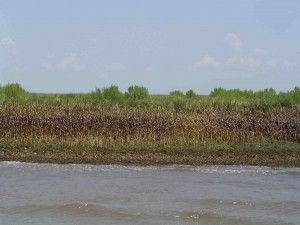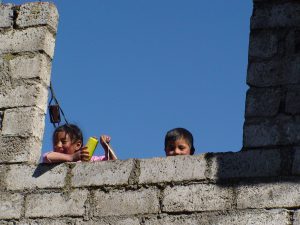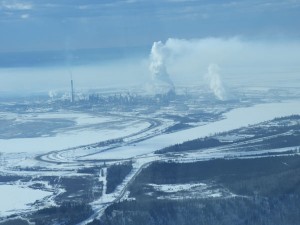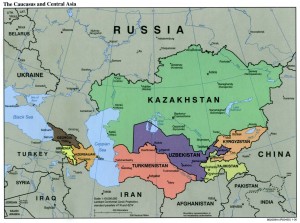BP’s “Missing Oil” coats wetlands and beaches along the waterways near St. Mary’s Parish, Louisiana, where no one is booming, cleaning, skimming, or watching.
(This article was originally posted on Huffington Post.)
 I am traveling the Gulf Coast writing a new book on the Gulf oil disaster.
I am traveling the Gulf Coast writing a new book on the Gulf oil disaster.
The good news is that the cap is holding. The bad news is that, with the well no longer gushing, the oil is out of sight and out of mind and BP is pulling up boom and pulling back workers, skimmers, cleaners, and the rest of the clean-up apparatus all across the Gulf. Even without new oil, the 40,000 barrels a day that spewed from the Macondo well for nearly 100 days continue to wash up on shores, including ones which no one is protecting or cleaning.
There is no shortage of people desperate to do this work. On Wednesday, July 28, Mayor Ron Davis of Prichard, Alabama took me to visit a packed Hazardous Waste Operations and Emergency Response (HAZWOPER) training class required for anyone involved in BP clean-up efforts. The city offers these classes for free. With unemployment at over 14% and poverty reaching 40%, the students who filled this, the tenth class, were effusive with gratitude. Although there is a waiting list over two months long to get in, as the the cleanup jobs shrivel away, this is the last class the city will offer.
The next night I attended a BP community forum in St. Mary’s Parish, Louisiana with representatives from BP, the U.S. Coast Guard, and other agencies available to talk to the public.
Here I met fishermen desperate to be put to work as part of BP’s Vessels Of Opportunity (VOO) program, using their boats to fish for oil instead of seafood by laying boom and absorbents and skimming. When the Parish President announced that St. Mary’s Parish did not, does not, and would not have oil, he was immediately surrounded by local fishermen, one of whom said loudly, “then why does Kermit have oil in his bag right now?” At which point the President turned off the mike and, in Kermit’s words, “all hell broke lose.”
Kermit Duck’s (yes, that’s his real name) grandfather, great grandfather, and so on, have been fishers in St. Mary’s Parish since Morgan City was founded. Kermit had spent that day looking for oil. He found a lot of it and brought some to the meeting in a ziplock bag to prove that it is out there. He is not a part of the VOO program, although he has spent two months on a waiting list trying to get hired. Instead, thanks to BP, he is four months unemployed and desperate to see a real clean-up effort take place so that one day he might be able to fish again.
On Friday Kermit took me out on a boat to show me the oil.
We spent five hours on the water traveling between Oyster Bayou and Taylor’s Bayou. We saw a lot of oil. With the exception of a small amount of boom outside of the Mouth of East Bay Junop, we saw no boom, skimmers, absorbents, or clean-up crews. The Juno boom was coated with oil, as was the area behind it.
We saw plenty of freshly oil-soaked grass and beach. The strong harsh smell of crude filled the air as we neared. The oil had washed up in waves, covering a large patch of grass here, leaving a clean patch beside it there. Fields of oil glistened as the sun picked up the oil’s sheen.
We walked along a shell beach on the south end of Oyster Bayou speckled throughout with fresh tar balls that reached from the reeds to inside the water’s edge. Kermit’s friend Buddy used an oar to dig below the beach surface, revealing more oil beneath.
Over the last months I have traveled the coasts of every state affected by the spill. Until this trip, every time I walked an area with oil, clean-up crews were never far behind. The oil would wash up, the crews would clean it, and the oil would wash up again. It was a sad dance to watch.
This is far more disturbing. BP’s oil continues to coat the Gulf Coast. The oil I saw yesterday was washing up into Louisiana’s vital wetlands, the last barrier of protection from hurricanes. If the grass remains unprotected and unclean, the oil can enter the root system, killing the grass forever. The oil was also at the mouth of Oyster Bayou, at the heart of St. Mary’s Parish’s way of life.
Before I left, Kermit assured me that his Parish President would now act and hold BP accountable to clean up the oil. Hopefully, he will not be alone in his efforts.
+++
For an interactive reportback from the Gulf Coast, join Antonia Juhasz and Kevin Danaher as they host a webinar conversation and Q&A about the impacts of the BP Oil Spill and what it means for the Green Economy. August 26th, 12pm PST.
(Do not use pictures without attaching tag line and photo credit)

Oil in grass between Oyster Bayou and Taylor's Bayou, St. Mary's Parish, Louisiana, July 30, 2010, Photo Credit: Antonia Juhasz.

Oil in grass between Oyster Bayou and Taylor's Bayou, St. Mary's Parish, Louisiana, July 30, 2010, Photo Credit: Antonia Juhasz.

Oil in grass between Oyster Bayou and Taylor's Bayou, St. Mary's Parish, Louisiana, July 30, 2010, Photo Credit: Antonia Juhasz.

Oil onshore and in waters' edge at South end of Oyster Bayou, St. Mary's Parish, Louisiana, July 30, 2010, Photo Credit: Antonia Juhasz.

Oil onshore at South end of Oyster Bayou, St. Mary's Parish, Louisiana, July 30, 2010, Photo Credit: Antonia Juhasz.

Oil South end of Oyster Bayou, St. Mary's Parish, Louisiana, July 30, 2010, Photo Credit: Antonia Juhasz.

Oil from reeds onshore between Oyster Bayou and Taylor's Bayou, St. Mary's Parish, Louisiana, July 30, 2010, Photo Credit: Antonia Juhasz.

Kermit Duck, St. Mary's Parish, Louisiana, July 30, 2010, Photo Credit: Antonia Juhasz

BP Community Forum, St. Mary's Parish, Louisiana, July 29, 2010, Photo credit: Antonia Juhasz

Prichard, Alabama, HAZWOPER Training Class, July 28, 2010, Photo credit: Antonia Juhasz.






 President Barack Obama will decide as early as September whether to approve a $7-billion, 1,700-mile long pipeline called Keystone XL to transport up to 900,000 barrels a day of tar sands crude from northern Alberta to refineries along the Gulf Coast of Texas.
President Barack Obama will decide as early as September whether to approve a $7-billion, 1,700-mile long pipeline called Keystone XL to transport up to 900,000 barrels a day of tar sands crude from northern Alberta to refineries along the Gulf Coast of Texas.
 THE TIME TO ACT IS NOW!
THE TIME TO ACT IS NOW!












